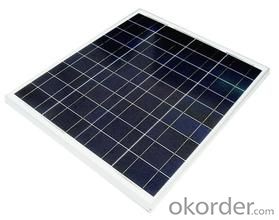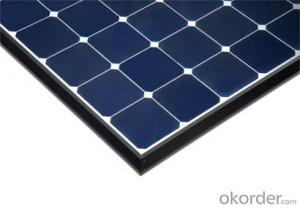CNBM Poly 230W Solar Panel with TUV UL CE Certificate For Residential
- Loading Port:
- Shanghai
- Payment Terms:
- TT OR LC
- Min Order Qty:
- 500 watt
- Supply Capability:
- 1000 watt/month
OKorder Service Pledge
OKorder Financial Service
You Might Also Like
Item specifice
CNBM Poly 230W Solar Panel with TUV UL CE Certificate For Residential
Introduction
Electrical connections are made in series to achieve a desired output voltage and/or in parallel to provide a desired current capability. The conducting wires that take the current off the modules may contain silver, copper or other non-magnetic conductive [transition metals]. The cells must be connected electrically to one another and to the rest of the system. Externally, popular terrestrial usage photovoltaic modules use MC3 (older) or MC4 connectors to facilitate easy weatherproof connections to the rest of the system.
Each module is rated by its DC output power under standard test conditions, and typically ranges from 100 to 365 watts. The efficiency of a module determines the area of a module given the same rated output – an 8% efficient 230 watt module will have twice the area of a 16% efficient 230 watt module. There are a few solar panels available that are exceeding 19% efficiency. A single solar module can produce only a limited amount of power; most installations contain multiple modules. A photovoltaic system typically includes a panel or an array of solar modules, a solar inverter, and sometimes a battery and/or solar tracker and interconnection wiring.
Micro-inverted solar panels are wired in parallel which produces more output than normal panels which are wired in series with the output of the series determined by the lowest performing panel (this is known as the "Christmas light effect"). Micro-inverters work independently so each panel contributes its maximum possible output given the available sunlight.[6
In contrast, a solar thermal collector supplies heat by absorbing sunlight, for the purpose of either direct heating or indirect electrical power generation from heat. A "photoelectrolytic cell" (photoelectrochemical cell), on the other hand, refers either to a type of photovoltaic cell (like that developed by Edmond Becquerel and modern dye-sensitized solar cells), or to a device that splits water directly into hydrogen and oxygen using only solar illumination.
Suggested application
Home lighting business lighting,
Garden lighting, pavement lighting
Farmer household lighting
Decorative water pump
Traffic signal lighting
Industry area
Business area
Solar Power Plant
Product feature
Modules are made of Monocrystalline or Polycrystalline Silicon cell.
Materials and color of the solar panel frame: Clear anodized aluminum alloy type 6063T5 Universal frame; Silver-white color;
The output connection gathers the coupling: Selects conforms to the IEC-612615; 2005, class II, IEC61730 international standard; Airtight waterproofing binding clamp;
Module seal structure: The surface is thick, the high diaphanous rate armored glass with solar cell board special-purpose 3.2mm becomes after the high temperature lamination craft. The back selects has waterproof and anti- aged performance fine TPT materials. The entire block battery board has, the waterproofing, the anti- aging airtight and so on the fine performance;
Power tolerance: +/-3%
Packaging
International standard cartons (according to the requirements of customers)
- Q:How do solar panels affect the roof's lifespan?
- Solar panels can actually help extend the lifespan of a roof. They act as a protective layer, shielding the roof from harmful elements such as UV rays, rain, and snow. Additionally, solar panels can reduce the temperature of the roof, which can help prevent heat-related damage.
- Q:What are the financial benefits of installing solar panels?
- Installing solar panels can provide several financial benefits. Firstly, solar panels allow homeowners to generate their own electricity, reducing their reliance on the grid and potentially lowering their monthly utility bills. Additionally, excess energy produced by solar panels can be sold back to the grid, resulting in potential income through net metering or feed-in tariffs. Moreover, investing in solar panels can increase the value of a property, making it more attractive to potential buyers and potentially leading to higher resale prices. Finally, solar panels can also qualify for various tax incentives, grants, or rebates, further reducing the initial installation costs and providing additional financial savings.
- Q:How do solar panels affect the electricity bill?
- Solar panels can significantly reduce or even eliminate electricity bills by generating clean and renewable energy from the sun. By harnessing solar power, these panels can offset a portion or all of a household's electricity consumption, thereby reducing the amount of power needed from the utility grid. This ultimately leads to lower electricity bills and potential savings over the long term.
- Q:Is it really possible for me living in Denver to build and install and setup my own solar panel to help make electricity for my home?
- Sure you can build your own solar panels, people do it all the time, especially with the efficiency of PV technology accelerating. How much you spend on a system depends on how much work you are willing to do for yourself, and how much and how efficiently you consume power. You can go all the way from high-end prefab installs that will run about $50 grand to fill the energy needs for an average 3/2 suburban home. You can buy kits and install them yourself, that cuts your price down quite a lot. You can purchase the components and put together a system yourself really cheaply. You can save even more money if you buy stuff used. You could actually build solar photovoltaic panels yourself, but it is a serious pain in the behind, you will need to use copper sheets and some highschool chemistry and do a lot of experimenting, and even if you do it right you definitly won't be able to replicate the power output available in manufactured silicone photovoltaic cells. So I say don't even bother. To get an idea of what a PV system for your local area might put out, use the PV-WATTS calculator at the government Renewable Resource Data Center. To learn how to build home solar energy systems, there's a lot of good free information online.
- Q:Our school is in the process of being built, but they have no plans to include any environmental benefits. I was wondering how to get a grant for solar panels (at least) or who I can talk to in order to get a grant.
- it quite is attending to be a actual crutch for Republicans isn't this? Cuts in those Bush era very own loan assure courses won't cover / 4 of the expenditures of in simple terms Irene on my own so shall we toss that argument out interior the trash, the place it belongs. this is devoid of going into the expenditures of the Midwest tornadoes, the fires in Texas and their drought, the fires in New Mexico, and the earthquake interior the Mid Atlantic. And greater to come again. in no way formerly in our historic past have we demanded that catastrophe alleviation for our human beings be tied to cuts in courses, and once you're honest, you will see that many different courses are on their slicing block too, lots of them an identical ones they tried to ram down our throats final time they dug of their heels, and seem how super that became out...our credit status went down. Are they loopy to choose greater?
- Q:Can solar panels be used to power a drone?
- Yes, solar panels can be used to power a drone. By harnessing the energy from the sun, solar panels can charge the drone's batteries and provide a sustainable source of power for extended flight times. This is especially beneficial for long-range or endurance missions where recharging options may be limited. Additionally, solar-powered drones offer environmental advantages by reducing carbon emissions and reliance on fossil fuels.
- Q:i know that a solar panel of square meter generate 000 watts on a clear and sunny day, but i need to know the time rate. is it 000 watts per day or per hour? Thanks.
- Build okorder /
- Q:can anyone help me? i was thinking of installing solar panels to cut bills but would it be a waste considering its gonna need a circulating pump running almost 24/7 (which will use electricity) and even still will only provide me with quot;warmwater? also would it be possible to install the solar panels for the sole purpose of providing sufficient power to run electric heaters instead of using gas/oil? this way allowing me to have a warm house without the expensive bills. brobably talking about running 7 heaters/electric radiators.
- A thermal solar panel to feed your water heater is the most efficient. But you need a classic heater system too when there is no or little sun. Solar panels to heat a home is not at all recommended. First of all, you get less day light and less sun in winter, so you won't get much electricity. They work best in summer, but electric panels have poor yields and are a very long term investment. You will need to wait years before saving money. Natural gas, a well isolated home, and a good old sweater is the best way to cut bills.
- Q:Can solar panels work in cloudy weather?
- Yes, solar panels can still generate electricity in cloudy weather. While their efficiency may be slightly reduced, they can still convert sunlight into usable energy even when the sun is not fully visible.
- Q:How will i construct solar panel?
- The first step to planning your system is to evaluate rebate options and obtain permits. Deciding the size of your system is the next step. With a grid-tied system, size is less critical, because the grid supplies power when your PV system falls short. Systems as small as a couple hundred watts are practical, but you can also install panels that will produce enough electricity for all your needs.
1. Manufacturer Overview |
|
|---|---|
| Location | |
| Year Established | |
| Annual Output Value | |
| Main Markets | |
| Company Certifications | |
2. Manufacturer Certificates |
|
|---|---|
| a) Certification Name | |
| Range | |
| Reference | |
| Validity Period | |
3. Manufacturer Capability |
|
|---|---|
| a)Trade Capacity | |
| Nearest Port | |
| Export Percentage | |
| No.of Employees in Trade Department | |
| Language Spoken: | |
| b)Factory Information | |
| Factory Size: | |
| No. of Production Lines | |
| Contract Manufacturing | |
| Product Price Range | |
Send your message to us
CNBM Poly 230W Solar Panel with TUV UL CE Certificate For Residential
- Loading Port:
- Shanghai
- Payment Terms:
- TT OR LC
- Min Order Qty:
- 500 watt
- Supply Capability:
- 1000 watt/month
OKorder Service Pledge
OKorder Financial Service
Similar products
New products
Hot products
Related keywords




























